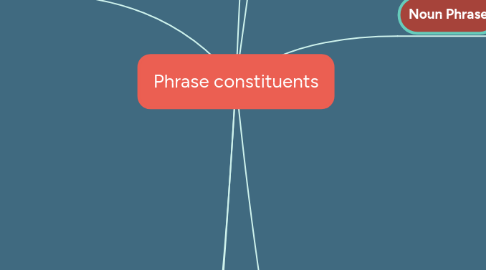
1. Each phrase is labeled according to the head of the phrase. The head can be a noun, a verb, an adjective, an adverb or a preposition.
2. Adjective Phrase
2.1. Functions
2.1.1. Premodifier in a noun phrase
2.1.2. Subject complement
2.1.3. object complement
2.1.4. Postmodifier in a noun phrase
2.1.5. Modifier of an adjective
2.1.6. Modifier of an adverb
2.1.7. Adverbial
2.2. Adjective as head can allow
2.2.1. many/more
2.3. Structure
2.3.1. Premodifiers can be:
2.3.1.1. Adverbs of Degree
2.3.2. Head (adjective)
2.3.2.1. Plain/positive
2.3.2.2. Comparative
2.3.2.3. Superlative
2.3.3. Postmodifiers can be:
2.3.3.1. Adverbs
2.3.3.2. Prepositional Phrases
2.3.4. (Premodifier) + Head adjective + (Postmodifier)
3. Verb Phrase
3.1. Verb head can bring to bear more control:
3.1.1. Excluding direct objects (Intransitive verbs)
3.1.2. Requiring direct objects (Transitive verbs)
3.1.3. Allowing a direct object without requiring one (Ambitransitive verbs)
3.1.4. Requiring indirect and direct objects (Ditransitive)
3.2. Function
3.2.1. Predicator
3.3. Structure
3.3.1. {Auxiliary verbs+} Main verb
3.3.1.1. The main verb can be a primary verb or a full verb
3.3.2. Auxiliary verbs can be:
3.3.2.1. Primary verbs
3.3.2.1.1. Be, Have, Do, Etc.
3.3.2.2. Modal auxiliaries
3.3.2.2.1. Can, May, Shall, Will, Must, Could, Might, Should, Would, Etc.
3.3.3. Intransitive verbs
3.3.3.1. Vi + A
3.3.4. Transitive verbs
3.3.4.1. Vt + DO {+OC} {+A}
3.3.5. Ditransitive verbs
3.3.5.1. Vd +IO +DO {+OC} {+A}
3.3.6. Linking verbs
3.3.6.1. Vl + SC + A
3.3.7. Ambitransitive verbs
3.3.7.1. Can be transitive, ditransitive or intransitive depending on the context
4. Adverb Phrase
4.1. Structure
4.1.1. (premodifiers) + Head Adverb + (postmodifiers)
4.1.2. Premodifiers can be:
4.1.2.1. Adverbs of degree
4.1.2.1.1. Amplifiers
4.1.2.1.2. Downtoners
4.1.3. Head can be:
4.1.3.1. Adverbs
4.1.4. Postmodifiers can be:
4.1.4.1. Prepositional phrases
4.1.4.2. Adverbs
4.2. Can modify:
4.2.1. Verbs
4.2.2. Adjectives
4.2.3. Adverbs of degree
4.2.4. A whole sentence
4.3. Functions
4.3.1. Of degree
4.3.2. Of evaluation
4.3.3. Adverbial
4.3.3.1. Modify:
4.3.3.1.1. A verb/ VP
4.3.3.1.2. Predicate
4.3.3.1.3. The whole rest of a clause
4.3.4. Premodifier of an adjective
4.3.5. Premodifier of an adverb
4.4. Types
4.4.1. Manner
4.4.2. Place
4.4.3. Direction
4.4.4. Frequency
4.4.5. Time
5. Noun Phrase
5.1. Noun head permits
5.1.1. Plural suffix
5.1.2. Definite/ Indefinite Articles
5.1.3. Words: same, less, fewer, etc
5.2. Structure
5.2.1. (premodifier) + Head Noun + (postmodifier)
5.2.2. Premodifiers can be:
5.2.2.1. Determiners
5.2.2.1.1. Specific
5.2.2.1.2. General
5.2.2.2. Enumerators
5.2.2.3. Genetive phrases
5.2.2.4. Adjectives
5.2.2.5. Nouns
5.2.2.6. Intensifiers
5.2.3. Head can be:
5.2.3.1. Adjective acting as a noun
5.2.3.2. pronoun
5.2.3.3. Enumerator
5.2.3.4. Genetive phrase
5.2.3.5. Noun
5.2.4. Postmodifiers can be:
5.2.4.1. Relative Clauses
5.2.4.2. Appositive Clauses
5.2.4.3. Postpositive Adjectives
5.2.4.4. Prepositional phrases
5.2.4.5. Infinitive clauses
5.3. Functions
5.3.1. Subject
5.3.2. Direct object
5.3.3. Indirect object
5.3.4. Subject complement
5.3.5. Object complement
5.3.6. Object of a preposition
5.3.7. Premodifier of a Noun/NP
5.3.8. Adverbial
6. Phrase Structure: ({M}H{M})
6.1. M: Modifiers (One or more)
6.1.1. Pre modifiers
6.1.2. Post modifiers
6.2. H: Head
7. Prepositional Phrase
7.1. Structure
7.1.1. Head
7.1.1.1. Preposition
7.1.2. Postmodifier
7.1.2.1. Object of a preposition
7.1.2.1.1. Noun phrase
7.1.2.1.2. Object pronoun
7.2. Functions
7.2.1. Adverbial
7.2.2. Postmodifier (Noun phrase)

